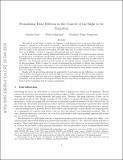| dc.contributor.author | Goldwasser, Shafrira | |
| dc.contributor.author | Vasudevan, Prashant | |
| dc.date.accessioned | 2021-01-26T18:16:09Z | |
| dc.date.available | 2021-01-26T18:16:09Z | |
| dc.date.issued | 2020-05 | |
| dc.identifier.isbn | 9783030457242 | |
| dc.identifier.isbn | 9783030457235 | |
| dc.identifier.uri | https://hdl.handle.net/1721.1/129575 | |
| dc.description.abstract | The right of an individual to request the deletion of their personal data by an entity that might be storing it – referred to as the right to be forgotten – has been explicitly recognized, legislated, and exercised in several jurisdictions across the world, including the European Union, Argentina, and California. However, much of the discussion surrounding this right offers only an intuitive notion of what it means for it to be fulfilled – of what it means for such personal data to be deleted. In this work, we provide a formal definitional framework for the right to be forgotten using tools and paradigms from cryptography. In particular, we provide a precise definition of what could be (or should be) expected from an entity that collects individuals’ data when a request is made of it to delete some of this data. Our framework captures most, though not all, relevant aspects of typical systems involved in data processing. While it cannot be viewed as expressing the statements of current laws (especially since these are rather vague in this respect), our work offers technically precise definitions that represent possibilities for what the law could reasonably expect, and alternatives for what future versions of the law could explicitly require. Finally, with the goal of demonstrating the applicability of our framework and definitions, we consider various natural and simple scenarios where the right to be forgotten comes up. For each of these scenarios, we highlight the pitfalls that arise even in genuine attempts at implementing systems offering deletion guarantees, and also describe technological solutions that provably satisfy our definitions. These solutions bring together techniques built by various communities. | en_US |
| dc.language.iso | en | |
| dc.publisher | Springer International Publishing | en_US |
| dc.relation.isversionof | 10.1007/978-3-030-45724-2_13 | en_US |
| dc.rights | Creative Commons Attribution-Noncommercial-Share Alike | en_US |
| dc.rights.uri | http://creativecommons.org/licenses/by-nc-sa/4.0/ | en_US |
| dc.source | arXiv | en_US |
| dc.title | Formalizing Data Deletion in the Context of the Right to Be Forgotten | en_US |
| dc.type | Article | en_US |
| dc.identifier.citation | Garg, Sanjam et al. "Formalizing Data Deletion in the Context of the Right to Be Forgotten." Advances in cryptology -- EUROCRYPT 2020, 39th Annual International Conference on the Theory and Applications of Cryptographic Techniques, Lecture notes in computer science, 12106, Springer, 2020, 373-402 © 2020 The Author(s) | en_US |
| dc.contributor.department | Massachusetts Institute of Technology. Department of Electrical Engineering and Computer Science | en_US |
| dc.relation.journal | Lecture Notes in Computer Science (including subseries Lecture Notes in Artificial Intelligence and Lecture Notes in Bioinformatics) | en_US |
| dc.eprint.version | Original manuscript | en_US |
| dc.type.uri | http://purl.org/eprint/type/ConferencePaper | en_US |
| eprint.status | http://purl.org/eprint/status/NonPeerReviewed | en_US |
| dc.date.updated | 2020-12-15T17:59:43Z | |
| dspace.orderedauthors | Garg, S; Goldwasser, S; Vasudevan, PN | en_US |
| dspace.date.submission | 2020-12-15T17:59:46Z | |
| mit.journal.volume | 12106 LNCS | en_US |
| mit.license | OPEN_ACCESS_POLICY | |
| mit.metadata.status | Complete | |
